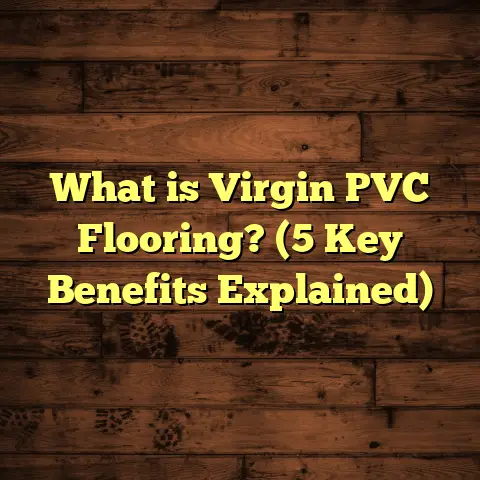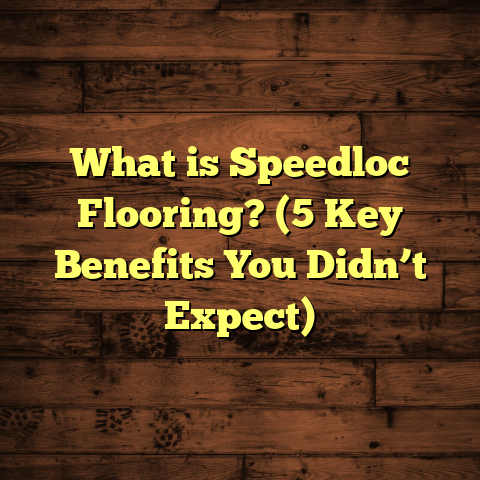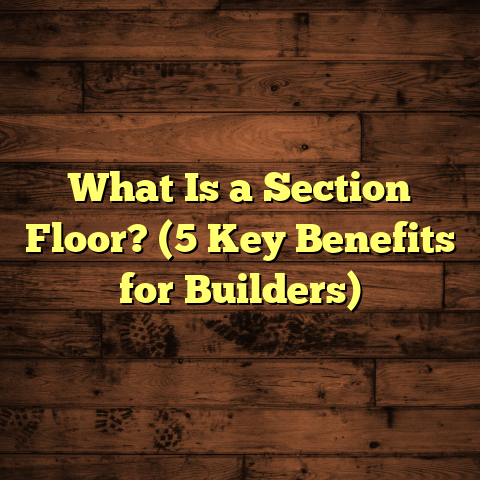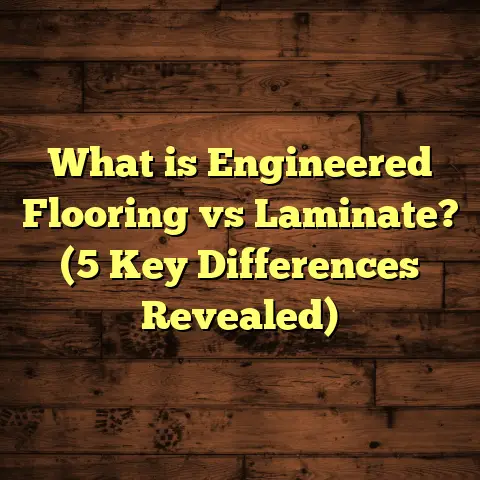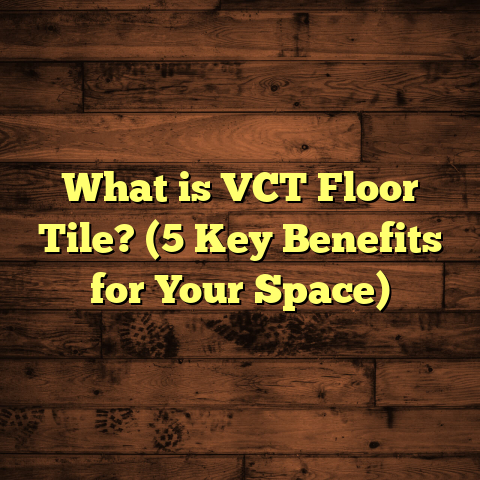What is a Floor Board? (5 Essential Facts for Homeowners)
Have you ever stood in your living room, staring down at your floor and wondered what those wooden planks really are? Or maybe you’ve been overwhelmed trying to pick the right flooring for your home without really knowing what a floor board even is? I’ve been there myself many times. When I first got into flooring, I thought floor boards were just simple pieces of wood nailed down. But as I worked more, I quickly realized that understanding floor boards is crucial to making the best choices for your home—choices that can impact everything from durability to comfort and even your budget.
Let me share with you the essential facts about floor boards that I’ve learned over years of hands-on work and research. I’ll also walk you through some personal stories, comparisons of different types of floor boards, and how I manage cost estimation using tools like FloorTally to make flooring projects easier and more predictable.
What Is a Floor Board?
At its simplest, a floor board is a long, narrow plank that forms the surface of your floor. Usually, these boards are made from wood, but that’s not the only option anymore. You can find floor boards made from laminate, vinyl, or engineered wood too.
When I first started installing floors, I figured all floor boards were basically the same—a piece of wood fixed to your subfloor. But over time, I learned there’s a lot more variety in types, structure, and quality.
Solid Hardwood Floor Boards
Solid hardwood boards are cut from one piece of timber. These are what you probably picture when you think of wooden floors. They’re prized for their natural beauty and longevity. For example, the oak boards in my grandmother’s house have been there for over 70 years and still look great after a few refinishes.
The downside? Solid hardwood reacts to moisture. If your home’s humidity isn’t controlled, these boards can expand or contract, sometimes causing gaps or buckling.
Engineered Wood Floor Boards
Engineered wood floor boards are made by layering thin slices of wood veneer on top of plywood or high-density fiberboard (HDF). This layered construction gives them better resistance to moisture changes.
I installed engineered wood in a client’s basement where humidity was an issue. Their floors stayed stable with no warping—something solid wood wouldn’t have handled as well.
Laminate Floor Boards
Laminate flooring is a synthetic product designed to look like wood. It’s made by fusing several layers including a photographic layer that mimics real wood grain.
I suggested laminate flooring to a family with two small kids and a dog. They loved how tough it was against scratches and easy it was to clean. However, laminate can’t be sanded or refinished like real wood. Once damaged, it needs replacement.
Vinyl Floor Boards
Vinyl planks are waterproof and come in many styles. They’re softer underfoot than wood or tile, which makes them popular for kitchens and bathrooms.
I’ve installed luxury vinyl planks (LVP) in laundry rooms and bathrooms where water exposure is frequent. They held up beautifully and gave the homeowners peace of mind.
Why Understanding Floor Boards Matters
You might wonder why all this detail about floor boards matters if you’re just trying to pick something nice for your house. Well, choosing the wrong type can lead to problems like warping, scratches, or even costly replacements sooner than expected.
For instance, I once worked on a project where the homeowners picked solid hardwood for their basement without considering moisture levels. A year later, the floor started buckling badly because the wood absorbed too much moisture from the concrete slab underneath.
Knowing what type of floor board suits your home’s environment and lifestyle can save you money and frustration in the long run.
Comparing Floor Board Options: What Works Best?
Let me break down some pros and cons based on my experience with each type:
| Floor Board Type | Pros | Cons | Typical Lifespan | Average Cost per Sq Ft (Materials + Installation) |
|---|---|---|---|---|
| Solid Hardwood | Durable, can be refinished multiple times, natural look | Sensitive to moisture, expensive | 50-100+ years | $8 – $15 |
| Engineered Wood | More moisture resistant, stable | Limited refinish ability (usually 1-2 times) | 20-40 years | $6 – $12 |
| Laminate | Affordable, scratch-resistant | Cannot be refinished | 10-20 years | $3 – $7 |
| Vinyl (LVP) | Waterproof, easy maintenance | Less natural appearance | 10-20 years | $4 – $9 |
How I Decided Which Flooring to Use: Personal Stories
In my first house renovation project, I chose solid oak floor boards for the living room because I loved the classic look and feel. The installation was straightforward, but after a humid summer, I noticed slight gaps appearing between the boards. That taught me how important climate control is for solid hardwood floors.
In another project for a client with two young kids who were tough on floors, I recommended laminate flooring. They were worried about scratches and stains—and laminate stood up well to both. However, when their dog scratched it deeply one day, they had to replace some planks since laminate can’t be refinished.
For homes in wetter areas or with basements, I’ve found engineered wood or vinyl planks to be safer bets. They handle moisture better and reduce risks of warping or buckling.
Installation Insights: What I’ve Learned Over Time
Installation quality can make or break your floor’s lifespan. Even the best floor board won’t perform well if installed incorrectly.
Moisture Testing Is Non-Negotiable
Early in my career, I learned this lesson the hard way when an installation failed because we skipped moisture testing on the subfloor. Moisture causes wood to swell or warp quickly.
Now I always check moisture levels using a moisture meter before installation. If levels are too high, we either delay the project until conditions improve or choose a more moisture-resistant flooring type.
Subfloor Preparation
A level and clean subfloor is critical. Uneven surfaces lead to squeaky floors or damaged boards down the line.
I once spent an entire day leveling subflooring in an older home before laying down engineered wood. It was tedious but saved headaches later.
Underlayment Choices
The right underlayment provides cushioning, soundproofing, and moisture protection. For laminate floors, foam underlayments work great. For hardwoods, felt paper or rubber underlayments often perform better.
DIY vs Professional Installation
Some homeowners want to install floors themselves to save money. While DIY can work for certain laminates or vinyl planks with click-lock systems, hardwood installation usually requires professional skills for nailing or gluing.
I’ve seen plenty of DIY jobs where improper nailing caused floors to loosen after just a few months.
Maintenance Tips Based on Floor Board Types
Taking care of your floor boards extends their life significantly.
- Solid Hardwood: Avoid wet mopping; use a damp mop with hardwood cleaner. Refinish every 7-10 years depending on wear.
- Engineered Wood: Clean with manufacturer-recommended products; avoid standing water.
- Laminate: Use dry or slightly damp mop; avoid abrasive cleaners.
- Vinyl: Easy to clean with mild detergent; avoid waxes that can make surface slippery.
How Cost Estimation Works: My Go-To Approach Using FloorTally
Estimating flooring costs can be tricky because prices vary widely by location and material quality. When I started out, I used spreadsheets and called local suppliers for quotes—but it was time-consuming and often inaccurate.
FloorTally changed all that for me. It’s an online tool that pulls local labor and material rates into one place so you get realistic estimates fast. It even factors in waste percentages so you don’t order too little or too much material.
For example, on a recent project for a 1,500 sq ft home wanting engineered wood floors:
- Material cost: $6 per sq ft
- Labor cost: $3 per sq ft
- Waste factor: 5%
FloorTally calculated total cost as: Total=(1,500×(6+3))×1.05=1,500×9×1.05=14,175Total = (1{,}500 \times (6 + 3)) \times 1.05 = 1{,}500 \times 9 \times 1.05 = 14{,}175
This gave my client confidence in their budget before any work began.
Industry Data That Supports My Experience
- The National Wood Flooring Association reports solid hardwood floors last over 100 years with proper care.
- According to HomeAdvisor’s 2023 data, average installation costs range from $6-$12 per sq ft depending on material.
- A recent survey by Houzz showed 65% of homeowners prefer engineered wood due to its durability in humid climates.
- Vinyl flooring sales have grown approximately 15% annually over the past five years as homeowners seek waterproof options.
Case Study: My Client’s Flooring Journey
A few months ago, I worked with a young couple renovating their first home. They wanted something durable for their toddler but also stylish enough for entertaining guests.
After inspecting their subfloor and understanding their lifestyle (lots of spills and occasional pet accidents), we narrowed down options to laminate or luxury vinyl plank (LVP).
We walked through pros and cons together:
- Laminate was scratch-resistant but vulnerable to water damage.
- LVP was waterproof but slightly more expensive upfront.
They chose LVP because they didn’t want to worry about water damage accidents while their child was learning to walk and explore.
Post-installation feedback? They love how easy cleaning is and how comfy the floors feel compared to tile or hardwood they considered initially.
Are you thinking about changing your floors or just curious about what kind you already have? Understanding these facts about floor boards can help you make smarter choices that fit your home’s needs perfectly.
Would you like me to help you figure out which type works best for your space? Or maybe share some tips on maintenance? Just ask!
